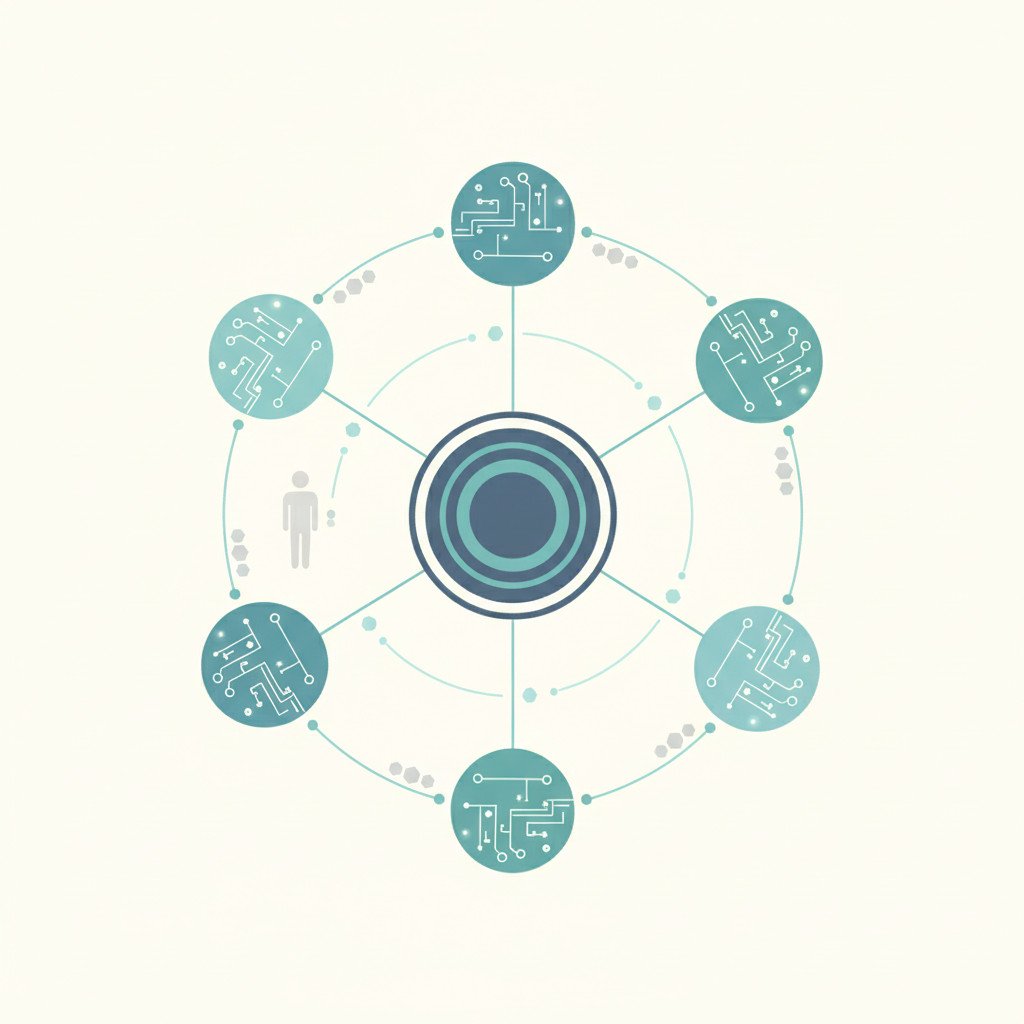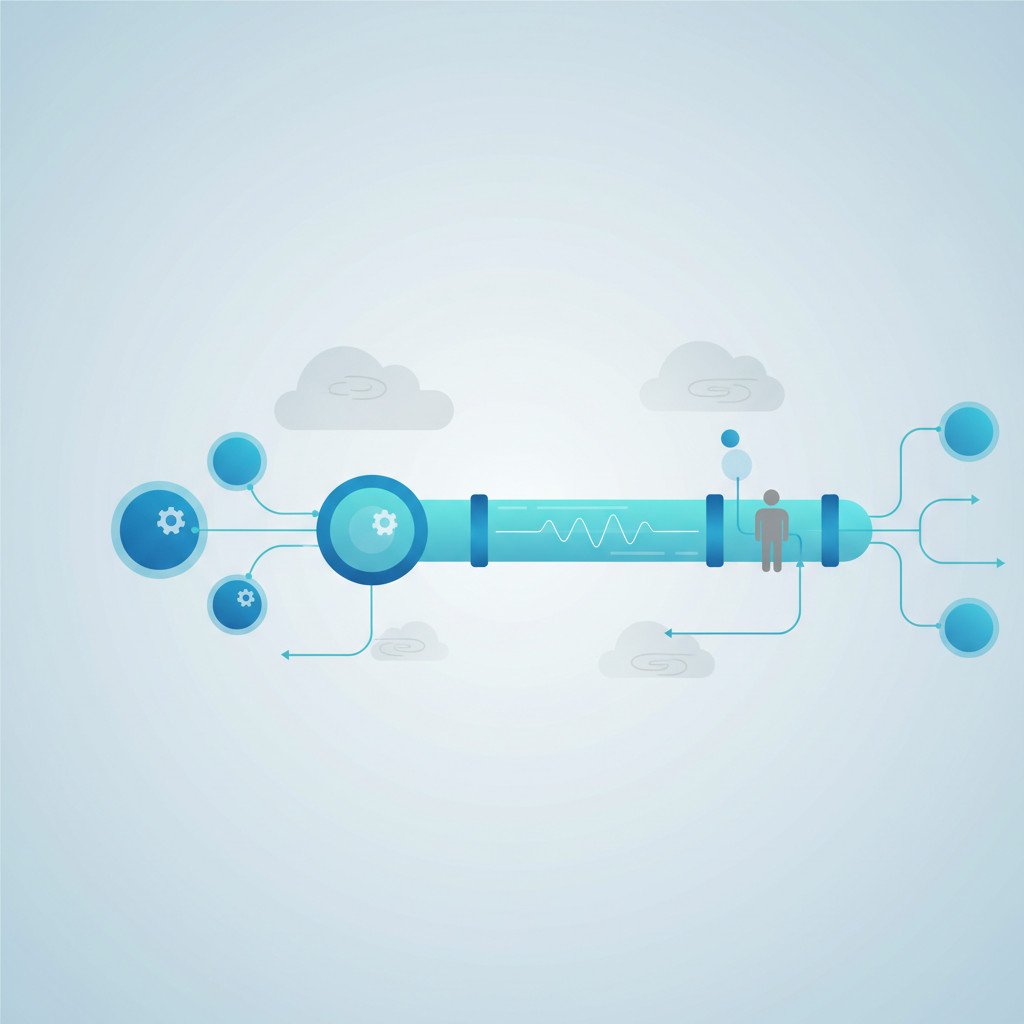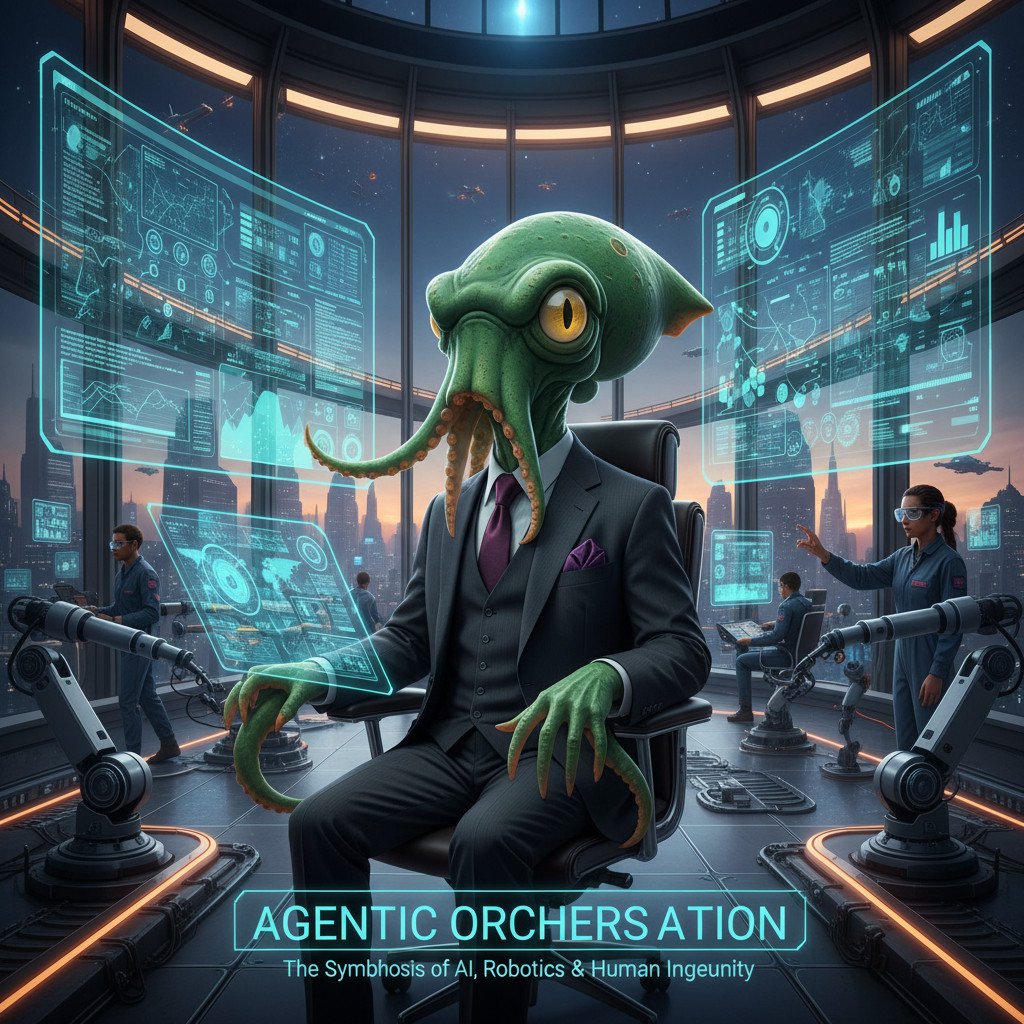Agentic orchestration: The Future of AI Automation
Agentic orchestration is the leap that turns isolated automation into resilient, adaptive systems. In this new era, AI agents work together to plan, execute, and correct complex workflows. As a result, businesses gain speed, accuracy, and continuous improvement. Therefore, companies can redirect skilled human talent toward higher value tasks.
The shift matters because traditional automation often fails at scale. However, agentic automation combines process intelligence, API integration, and real-time data-driven decision making. Moreover, it blends RPA, AI agents, and humans in the loop to bridge legacy systems and modern platforms. Consequently, supply chain management and manufacturing become more predictive and responsive. For example, demand forecasting and dynamic pricing optimize inventory and margins.
Technically, agentic orchestration layers coordination logic above individual agents. It orchestrates task delegation, error recovery, and feedback loops. Furthermore, it enables end-to-end manufacturing workflows that self-adapt to disruptions. As Industry 4.0 advances, this approach unlocks measurable ROI. Finally, this article explains how organizations build, test, and scale agentic orchestration for real business value.
By combining agentic orchestration with process mining and intelligent monitoring, teams reduce downtime and boost throughput. Furthermore, vendors like Peak AI and UiPath bring specialized capabilities to market. Therefore, leaders should evaluate pilot projects that link automation to strategic outcomes.
What is Agentic orchestration in AI automation?
Agentic orchestration coordinates multiple AI agents to complete complex tasks. In plain terms, it lets intelligent agents act together. Therefore, systems move beyond single-task bots. As a result, automation workflows become resilient and adaptive. Moreover, agentic orchestration adds a coordination layer that manages task allocation, retries, and escalation. This layer links robotic process automation, APIs, and humans in the loop.
Main components of agentic orchestration: intelligent agents and automation workflows
- Orchestration layer
- Routes tasks and prioritizes workflows.
- Monitors progress and triggers recovery when needed.
- Intelligent agents
- Perform specialized actions such as data extraction, decisioning, and API calls.
- Learn from feedback and improve over time.
- Connectivity and integration
- Use APIs, RPA connectors, and IDP to bridge legacy systems.
- Provide real-time data streams for process intelligence.
- Observability and feedback loops
- Collect telemetry for analytics and process mining.
- Feed insights back to agents to refine behavior.
- Human-in-the-loop controls
- Allow humans to intervene for exceptions and audits.
- Ensure compliance and governance across workflows.
Why agentic orchestration matters for businesses
Agentic orchestration reduces manual handoffs and speeds decision making. Consequently, teams cut cycle times and lower error rates. For example, combining agentic orchestration with demand forecasting can optimize inventory and pricing. Furthermore, vendors are already building tools to simplify adoption.
See how organizations move from pilots to scale in this guide on converting experiments to business value: What steps turn agentic orchestration experiments into scalable business value?. Also, the nontechnical foundations matter; review readiness best practices here: How Do You Prepare Your Organization for Agentic AI Success?. Finally, explore desktop AI agents and desk-side teammates in this related piece: How Will Gemini Enterprise Turn Every Desk into an AI-Enabled Workspace?.
By uniting orchestration, intelligent agents, and integration, organizations gain adaptive automation. Therefore, they can achieve Industry 4.0 goals without ripping and replacing existing systems.

Benefits of Agentic orchestration for businesses and industries
Agentic orchestration delivers measurable business value across operations. It accelerates AI automation while keeping humans in the loop. Therefore, teams get faster cycle times and clearer outcomes. Moreover, this approach turns isolated bots into cooperative systems that solve end-to-end problems.
Key benefits
- Increased efficiency
- Agentic orchestration reduces manual handoffs and repetitive tasks. Consequently, teams cut processing times and lower error rates. For example, quote automation implementations have cut response times by more than 90%, which improves customer experience and conversion rates.
- Scalability and elasticity
- Systems scale horizontally by adding specialized agents. As a result, capacity grows without rigid replatforming. Vendors can deploy vertical agents for pricing, inventory, and demand forecasting to expand capabilities quickly.
- Faster time to value
- Pilot projects convert to production faster because agents encapsulate domain knowledge. Therefore, organizations realize ROI sooner and reinvest savings into new automation workflows.
- Resilience and adaptive operations
- Orchestration monitors progress and triggers recovery steps. Consequently, workflows adapt to data drift, supply shocks, or external events. This resilience supports Industry 4.0 goals like reduced downtime and better throughput.
- Improved decision quality
- Intelligent agents combine real-time telemetry with business rules. Moreover, they surface recommendations for human review. Thus, teams make more accurate and timely decisions in procurement and pricing.
- Workforce uplift and talent leverage
- Agents handle routine work, which frees skilled staff for higher value tasks. As a result, organizations redirect talent toward innovation and process improvement.
- Better governance and compliance
- Orchestration provides audit trails, alerting, and role-based controls. Therefore, companies maintain oversight while scaling automation across departments.
Practical example
Heidelberg Materials saw quote-automation reduce average request-to-quote time from eight hours to thirty minutes. As a result, conversions improved and sales cycles shortened. This case shows how agentic orchestration converts technical capability into bottom-line impact.
In short, agentic orchestration combines intelligent agents, connectivity, and orchestration logic. Consequently, businesses achieve more efficient, scalable, and profitable automation.
| Dimension | Traditional automation | Agentic orchestration | Typical business impact |
|---|---|---|---|
| Capabilities | Executes prebuilt, linear tasks. It follows scripted rules and fixed workflows. | Coordinates multiple intelligent agents that plan, act, and learn. It supports decisioning and complex workflows. | Faster task completion and fewer manual steps. Teams can automate end-to-end processes. |
| Flexibility | Low. Changes require rework or new scripts. It struggles with variability. | High. Agents adapt to context and exceptions. Orchestration reroutes tasks in real time. | Reduced maintenance and quicker adaptation to new business rules. |
| Scalability | Vertical scaling is common. Adding new capabilities often needs replatforming. | Horizontal scaling by adding specialized agents and services. It scales across domains. | Faster expansion of automation with lower integration cost. |
| Resilience and recovery | Limited error handling. Failures often need human fixes. | Built-in monitoring and recovery loops. Agents retry or escalate automatically. | Less downtime and improved service levels. Operations stay stable during shocks. |
| Integration and connectivity | Relies on RPA connectors or point integrations. It can be brittle with legacy systems. | Uses APIs, event streams, and adapters to unify data and systems. Agents share state. | Better data flow and faster cross-system processes. |
| Governance and auditability | Audits are possible but often fragmented across tools. | Centralized observability, logs, and role controls. It enforces policies consistently. | Stronger compliance and faster audits. |
| Time to value | Can be quick for simple use cases but slow at scale. | Faster for complex outcomes because agents reuse domain logic. | Quicker ROI on strategic processes and reinvestment into further automation. |
This comparison shows why organizations pursuing Industry 4.0 favor agentic orchestration. Consequently, they achieve more resilient, scalable, and integrated automation.
Real-World Use Cases of Agentic orchestration
Agentic orchestration already powers tangible wins across marketing, sales, and growth systems. Below are three concrete areas where organizations see measurable improvements. Each example shows how coordinated intelligent agents deliver outcome-driven automation.
Marketing automation: orchestrated campaigns and personalization
-
Use case
Multiple agents coordinate content selection, audience segmentation, and multichannel delivery. As a result, campaigns run with consistent timing and personalized content.
-
Why it matters
Campaigns scale without ballooning headcount. Moreover, agents optimize messaging by testing and learning in production.
-
Example
Platforms like Salesforce Einstein add AI decisioning to CRM workflows. For more on vendor capabilities, see Salesforce Einstein.
Sales process optimization: faster quoting and higher conversion
-
Use case
Agents extract request details, fetch pricing rules, validate constraints, and assemble quotes. Then orchestration routes approvals or human reviews.
-
Why it matters
This cuts request-to-quote times and boosts win rates. Consequently, sellers close deals faster and serve more customers.
-
Example
Heidelberg Materials reduced quote time dramatically after deploying agentic automation. Reports show quote generation dropped from hours to under an hour, improving conversions. See reporting on the implementation here.
AI-powered growth systems: end-to-end revenue operations
-
Use case
Growth systems stitch lead scoring, pricing engines, and fulfillment pipelines together. Therefore, agents coordinate signals to move prospects through the funnel.
-
Why it matters
Organizations gain a single source of truth for revenue actions. As a result, teams target high-value opportunities and reduce friction between marketing and sales.
-
Example
UiPath’s acquisition of Peak accelerates vertically specialized agents for pricing and inventory. Consequently, companies can deploy domain-specific agents quickly. Learn more.
In sum, agentic orchestration makes cross-functional processes faster and smarter. Therefore, leaders should pilot tightly scoped use cases and measure real business impact before scaling.

Challenges and Solutions in Agentic orchestration
Implementing Agentic orchestration brings clear benefits, but it also introduces challenges. Below are common hurdles and pragmatic solutions to address them. Use these best practices to reduce risk and speed adoption.
Integration complexity and legacy systems
-
Challenge
Many enterprises run older systems that do not expose clean APIs. As a result, agents face brittle integrations and data silos.
-
Solutions
- Adopt a layered adapter strategy that wraps legacy endpoints. Consequently, you avoid wholesale rip and replace projects.
- Use event-driven patterns and standardized APIs to decouple agents. Therefore, teams can swap or upgrade components without breaking workflows.
- Invest in an integration testing harness to validate end-to-end flows before production.
Data privacy and regulatory compliance
-
Challenge
Agents often process sensitive data across domains. Therefore, companies risk noncompliance with privacy laws.
-
Solutions
- Enforce data minimization, masking, and role-based access controls. As a result, you limit exposure and reduce audit scope.
- Map flows to regulatory requirements and document controls. For guidance, review frameworks like GDPR and align controls to legal obligations.
- Automate retention policies and consent checks inside orchestration policies.
System security and threat surface
-
Challenge
Agent ecosystems expand the attack surface. Consequently, unauthorized agents or forged messages can create risks.
-
Solutions
- Use strong identity and mutual TLS between agents and services. Also, implement a zero trust model and continuous monitoring.
- Apply threat modeling and harden agent runtimes. Moreover, follow standards such as the NIST Cybersecurity Framework.
Model drift, governance, and observability
-
Challenge
Models degrade and drift over time. As a result, decisions may become less accurate.
-
Solutions
- Instrument telemetry and use process mining to detect drift early. Then implement automatic rollback and human review gates.
- Create a governance board to approve agent roles, SLAs, and escalation rules. Therefore, you gain consistent, auditable change control.
Operational complexity and talent
-
Challenge
Orchestration needs orchestration engineers and cross-functional skills.
-
Solutions
- Start with narrow pilots, document runbooks, and upskill existing teams. Consequently, organizations build repeatable patterns and scale responsibly.
By anticipating these issues and applying the solutions above, teams can deploy Agentic orchestration with confidence. As a result, businesses realize resilient, compliant, and secure automation at scale.
Future outlook: Agentic orchestration and the road ahead
Agentic orchestration will shape the next wave of AI-driven transformation. As AI models grow more capable, agents will handle richer tasks and make more reliable decisions. Therefore, automation moves from repeatable scripts to adaptive systems that learn in production.
Emerging trends
- Advanced model integration
- Expect tighter coupling between large language models and specialized agents. As a result, agents will combine natural language understanding with domain-specific logic to act autonomously.
- Verticalized agent marketplaces
- Vendors and ecosystems will offer plug-and-play agents for finance, manufacturing, and commerce. Consequently, teams will adopt specialized components faster without heavy custom code.
- Edge and real-time orchestration
- Orchestration will extend to edge devices and on-prem systems. Therefore, low-latency decisioning will support robotics, IoT, and shop-floor automation.
- Stronger governance and standards
- As adoption rises, governance frameworks will mature. Moreover, standard APIs and observability practices will make integrations safer and repeatable.
Business impact and adoption
Organizations will accelerate digital transformation because agentic orchestration reduces integration friction. Consequently, leaders can link legacy systems with modern AI agents without ripping and replacing platforms. Moreover, teams will focus on outcome-driven automation, measuring throughput, uptime, and revenue impact.
Challenges and opportunities
Regulation, explainability, and talent remain hurdles. However, tooling for observability and human-in-the-loop controls will improve. As a result, companies can scale with confidence while protecting privacy and security.
In short, Agentic orchestration will be central to Industry 4.0. Therefore, early pilots with clear metrics will separate experiments from scalable value.
Conclusion: Agentic orchestration as the multiplier for AI-driven growth
Agentic orchestration transforms automation from brittle scripts into adaptive, coordinated systems. As a result, companies gain speed, accuracy, and resilience across operations. Therefore, leaders who combine orchestration with process intelligence unlock measurable ROI and faster digital transformation.
EMP0 stands ready to help organizations realize that value. As a leader in AI and automation solutions, EMP0 offers ready-made tools like Agentic Automation, Agentic Testing, Test Cloud, Agent Builder for testers, and Autopilot for testers. Moreover, EMP0 delivers full-stack, brand-trained AI workers. Consequently, clients get AI-powered growth systems under their control that multiply revenue while preserving oversight.
Practical advantages of partnering with EMP0
- Faster deployments because EMP0 provides reusable agent patterns and vertical playbooks.
- Clear governance since solutions include observability, audit logs, and human-in-the-loop controls.
- Revenue-focused outcomes through integrated pricing, quoting, and demand forecasting components.
If you want to explore agentic orchestration, EMP0 publishes practical guidance and case studies. Visit EMP0 online to learn more: Website and Blog. You can also follow social updates at Twitter X handle @Emp0_com, read longer essays on Medium at medium.com/@jharilela, or connect with automation workflows at n8n.io/creators/jay-emp0.
Start with a small, outcome-driven pilot. Then iterate and scale. As Industry 4.0 advances, agentic orchestration will be the engine that turns AI into sustainable business advantage.

